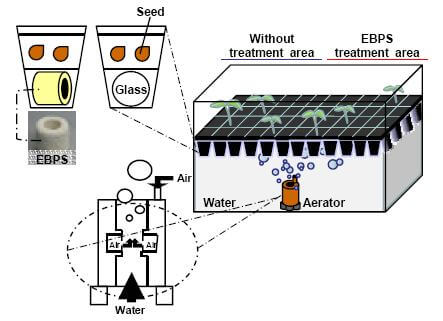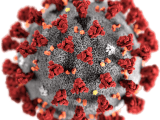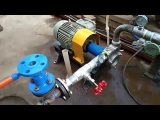When the REO laboratory (Matsushima City) applied the technology of supermicrobubble
“Nanobubble” to rice farming, The experiment was successful. It was
proven that the growth of the rice plant was also active and act as a strong assistant
to organic farming.
This laboratory is advancing the research that applies the nanobubble to agriculture,
aquaculture, and the medical treatment with independent National Institute of
Advanced Industrial Science and Technology (Ibaraki Prefecture Tsukuba city). The
results of the use of ozone to sterilization and the disinfection ( killing the virus) of
the fresh fishes as well as finished fish products keeping their freshness have been
achieved.
In the experiment, the seedling was planted in the experiment rice field of about
four acres in east Matsushima City Yamoto The micro nanobubble water was drawn
in from the generation device set up sideward of the rice farm. Then the growth of
the rice plant are examined.
The division that uses the nanobubble was a lot better compared with the division
that not used nano bubbles. The growth rate of stalks were faster, deeper roots,
and fewer weeds.
When the rice field has been surveyed in cooperation with Department of
Agriculture, Prof. Masahiko Tamaoki of Meiji era said, “It amazed me that the rice
plant grow up faster”. This technology is a good development, its very effective.
Now I understand the mechanism of Nano-bubble and its applications.” he said.
The Office of Research and Development Institute, general manager Kaneo Tiba said
that Nano-bubbles help improves the quality of soil . The weeds doesn’t grow, it
will be effective to organic farming. Everyone were very enthusiastic about the
technology.
Introduction
In recent years human activities have caused wide variety of environmental
problems. Significant damage to the environment, to plants and animals. Water
pollution and the plant effluent has caused big damage to closing waters
environment such as lakes and marshes and oceans.
Condition of Long Stagnated Water Area
Eutrophication is an increase in chemical nutrients — typically compounds containing
nitrogen(N) or phosphorus(P) — in an ecosystem, and may occur on land or in water.
However, the term is often used to mean the resultant increase in the ecosystem’s
primary productivity (excessive plant growth and decay), and further effects
including lack of oxygen and severe reductions in water quality, fish, and other
animal populations.
Eutrophication is frequently a result of nutrient pollution such as the release of
sewage effluent and run-off from lawn fertilizers into natural waters although it may
also occur naturally in situations where nutrients accumulate (e.g. depositional
environments) or where they flow into systems on an ephemeral basis.
Eutrophication generally promotes excessive plant growth and decay, favors certain
weedy species over others, and is likely to cause severe reductions in water quality. In
aquatic environments, enhanced growth of choking aquatic vegetation or
phytoplankton (that is, an algal bloom) disrupts normal functioning of the ecosystem,
causing a variety of problems such as a lack of oxygen in the water, needed for fish
and shellfish to survive. The water then becomes cloudy, colored a shade of green,
yellow, brown, or red. Human society is impacted as well: eutrophication decreases
the resource value of rivers, lakes, and estuaries such that recreation, fishing,
hunting, and aesthetic enjoyment are hindered. Health-related problems can occur
where eutrophic conditions interfere with drinking water treatment.
In the northern part of Chiba Prefecture, the urbanization and industrial
wastewater pollution caused by eutrophication is progressing.
In this research, micro-nano-bubble technology was applied to treat the water
problem in lakes and inner bays..
Experiment method
2-1. Assessment of plant growth and water quality; Nitrification by bacteria and
oxygenated water-filtration method To maximize the processes, air is blown into the
water through diffusers so that the bacteria have a constant supply of oxygen
A water treatment reaction tank comprising: special microbes ; filtration
ceramics EBPS; on the upper part are Caiware radish sprouts . All were set up in a
tank containing 35L of wastewater from muddy lake , a micro/nano bubble
reaction generators provided in the nitrification tank.
Starting from experiment 3, 6, 9, 12, 16, 21, 24 days after the concentration of
dissolved oxygen in the bottom of muddy water (DO), chemical oxygen demand
(COD), nitrogen concentration of nitrite (NO2 – N), nitrate Concentration of nitrogen
(NO3 – N), concentration of ammonia nitrogen (NH4 +-N), phosphorus concentration
of phosphate (PO43 – P) was measured.
The rate of germination of radish sprouts, and the length of the stem (growth rate)
was calculated.
Water quality and plant growth assessment
(2-1) at the end of the experiment, For one month without changing the muddy
water in the tank. The seeds/EBPS and the Caiware radish was newly comprised and
set up, with the air supply system. The testing was every two days within 18 days,
the DO, COD, NO2 – N, NO3 – N, NH4 +-N, PO43 – P were measured and the effects
of oxygen concentration was examined.
The germination rate of radish sprouts, and the growth rate (length of the stem) was
calculated.
3. Results and Discussion
3-1. Assessment of plant growth -Nitrification by bacteria-containing air supply
and water quality by filtering agent
-The supply of air by the aerator increased DO in the liquid rapidly, and the
aerobic microbe was activated. DO is consumed along with this, and reversed the
increase of COD in the liquid.
-Organic nitrogen and the phosphorus contained in the bottom mud were made
inorganic by the microorganism, and the change was seen in the density of the liquid
at the same time.
-Inorganic nitrogen has been particularly focused on, and put radish sprouts at the
base of the EBPS NH4 + → NO2-→ NO3-. A reactive promotion where radish sprouts
promote absorption of nutrients and oxygen supply to the root of the elongation
effect Obtained.
The Caiware radish germinated on three days after growing both in EBPS areas and
the unprocessing areas. The growth was confirmed. Cultivation in the final period and
checking the germination rate of radish sprouts after the first 14 days. EBPS
Processing area is 44.0%, 15 ± 1.0cm, while pending area is 22.7%, 13 ± 1.4cm.
3-2. Sustainable supply of air and water quality have a big impact for plant growth
As for DO, it is maintained to about 8ppm and the aerobic microbe has been
improved to revitalization by preserving it during month with continous air supply.
However, the value of NO3-N in the liquid rose up to 5ppm because the root of the
Caiware radish that had absorbed NO3-N had been removed. PO43-P combines
with Fe etc. under aerobic conditions. The Fe3 + adsorbed, precipitated and
oxidized becomes a steady FePO4. Though it is not easily dissolved into water, it
reduced to 0.04ppm.
Under such an environment, where radish sprouts were grown hydroponically in
place. With continuing on and off air supply and there’s no PO43-P, and when the
supply was stopped, a high value was indicated. It is because the aerobic microbe
is activated by the air supply, and the circulation of N and P functioned very well.
FePO4 have been reduced in fluid form in an aerobic environment, and becomes
Fe2(PO4) 3, and melted to water. The release of PO43-P promotes dissolution for
the Fe2 +. The PO43-P concentration in the fluid increased.
Cultivation in the final period of 12 days ,the germination rate of radish
sprouts was 15.9cm , the oxygen-supply conditions was 21.5%.
(Reference – http://www.asahi.com/food/news/TKY200808080222.html)







